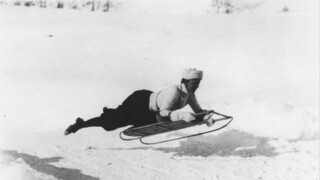On the Cresta Run
Jeremy Bernstein
I made my first trip to Tibet in 1987. One of my companions was a former British army officer called Garry Daintry, who told me that during the winter he helped out on the Cresta Run in St Moritz. The Cresta is an ice chute that you descend on a ‘skeleton’, a toboggan that you lie down on head first, and which has neither brakes nor any steering mechanism. You can try to control the speed by ‘raking’, rubbing the spikes of your special shoes on the ice, but you will inevitably reach speeds approaching sixty miles an hour.
The activity was invented by the British in the 19th century, when the skeleton went faster than any other vehicle on earth. I got the somewhat lunatic idea that I would like to run the Cresta and asked Daintry how I could go about it. He said that I could take out temporary membership of the St Moritz Tobogganing Club which would entitle me to a few rides, and this I did in 1988. I took one ride from a place in the middle of the course called the Junction where beginners start. I must have reached at least fifty miles an hour with my face not many inches from the ice. One ride was enough.
The Cresta – or more precisely a toboggan race on skeletons – was an Olympic event in 1928 and 1948, but only became a permanent fixture in 2002. This meant that it was open to women. In St Moritz, women are still not allowed to ride the Cresta Run; they were banned in 1929 because it was claimed that riding the Cresta might make them susceptible to breast cancer. The real risk was that they were required to wear ankle-length skirts. Despite this handicap, Ursula Wheble ‘rode the Cresta on equal terms with the men’.
The 2017 International Bobsleigh and Skeleton Federation World Championships were to be held in Sochi in Russia. But on 13 December the IBSF decided to move the competition; earlier this week they announced they would hold it in Königssee instead. On 9 December, the World Anti-Doping Agency published the second part of Richard McLaren’s Independent Investigations Report, which found that ‘an institutional conspiracy existed across summer and winter sports athletes who participated with Russian officials within the Ministry of Sport and its infrastructure.’
